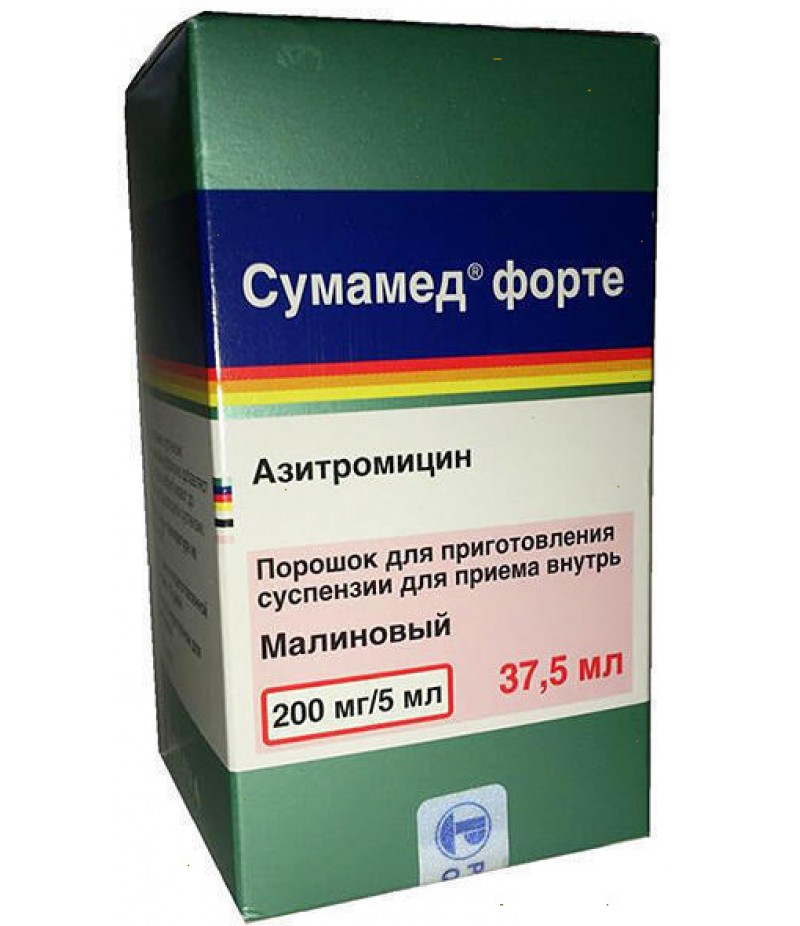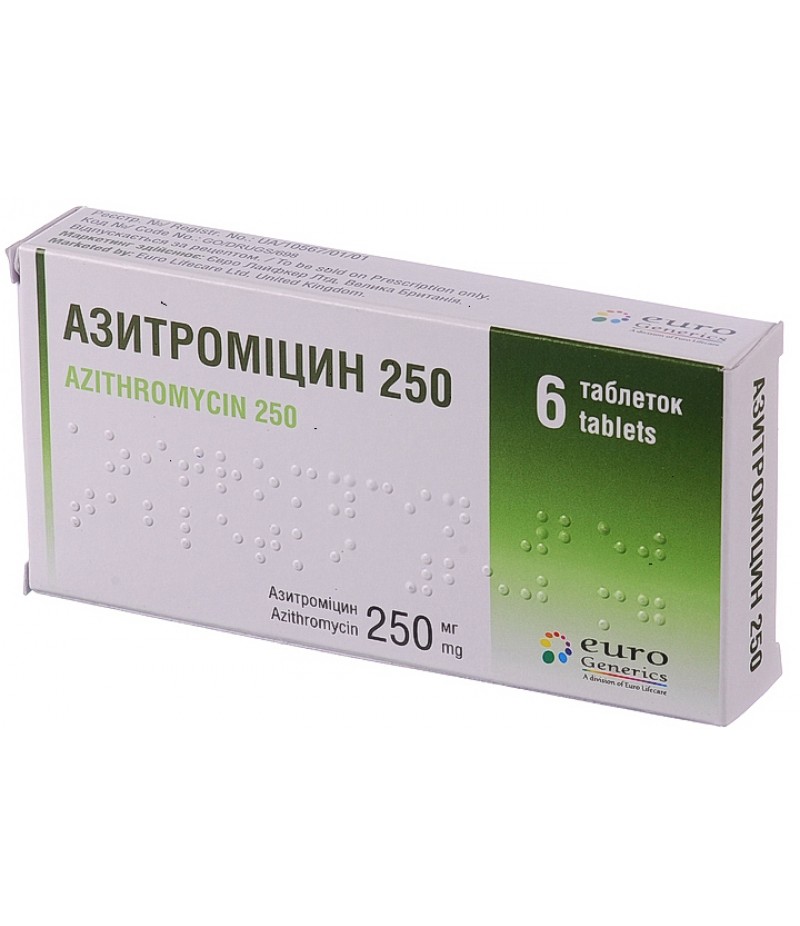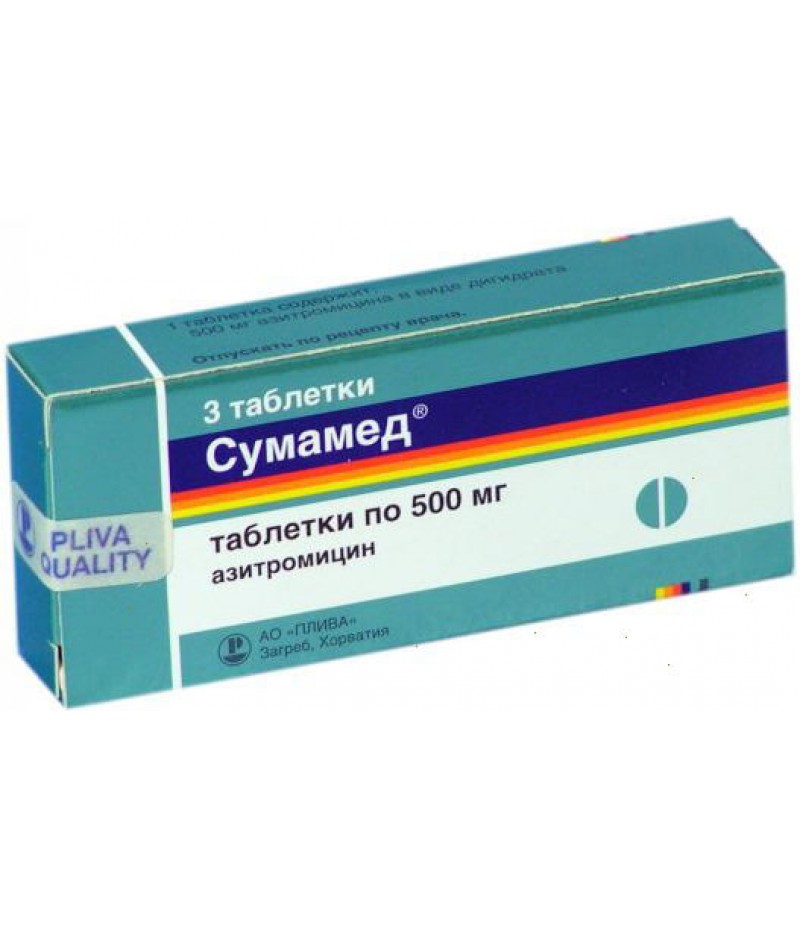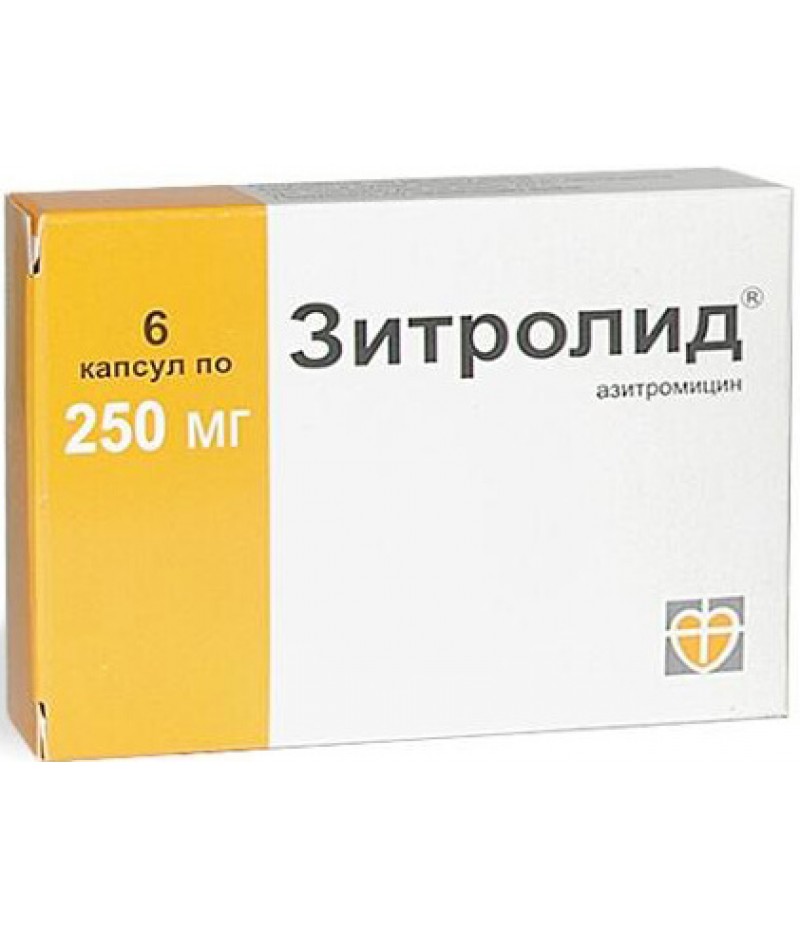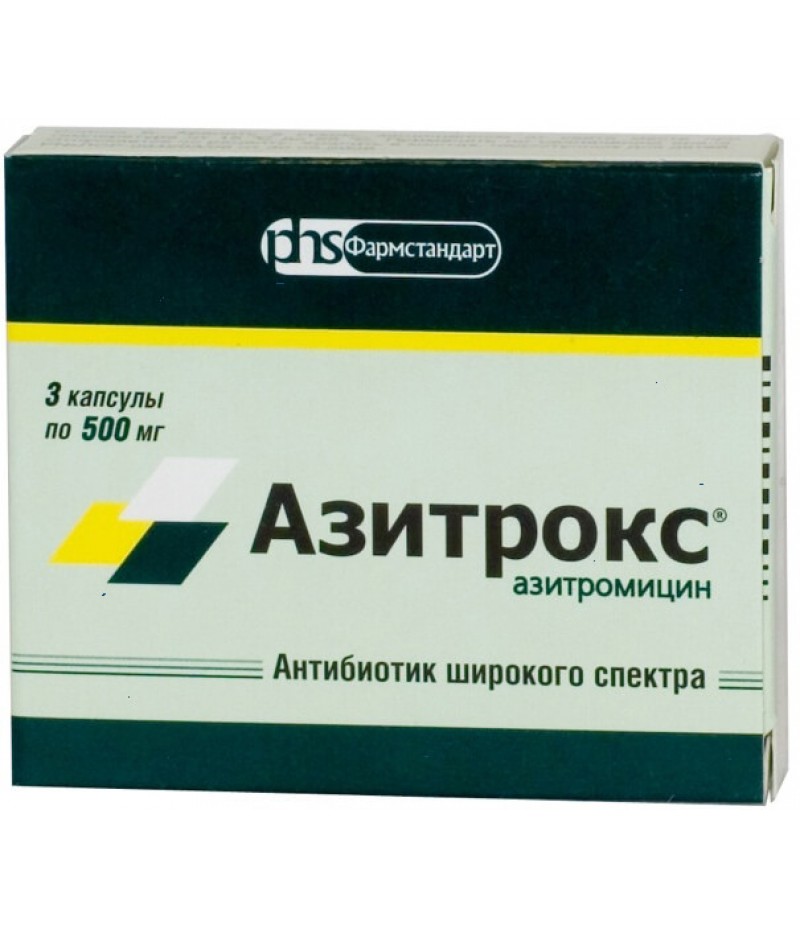Sumamed Forte powder 200mg/5ml 35,573gr #1
- $32.93
- 3 or more $29.99
- Availability:In Stock
Sumamed Forte instructionReed more and buy Sumamed Forte hereCompositionThe composition of 1 gram of the drug Sumamed Forte contains 47.79 mg of azithromycin dihydrate.Additional components: titanium dioxide, sodium phosphate, suc..
Tags: powder
Sumamed Forte instruction
Reed more and buy Sumamed Forte here
Composition
The composition of 1 gram of the drug Sumamed Forte contains 47.79 mg of azithromycin dihydrate.
Additional components: titanium dioxide, sodium phosphate, sucrose, giprolose, raspberry flavor, xanthan gum, silicon dioxide.
Form of issue
White powder for making a suspension for oral ingestion with the aroma of banana. After dilution in water it turns into a white homogeneous suspension with the aroma of a banana.
16,74 grams or 15 ml of powder in a 50 ml polyethylene bottle together with a measuring spoon and a syringe in a cardboard bundle.
29,295 grams or 30 ml of powder in a 100 ml polyethylene bottle together with a measuring spoon and a syringe in a cardboard bundle.
35.573 grams or 37.5 ml of powder in a 100 ml polyethylene bottle together with a measuring spoon and a syringe in a cardboard bundle.
pharmachologic effect
Antibacterial action.
Pharmacodynamics and pharmacokinetics
Pharmacodynamics
Antibiotic bacteriostatic action, relating to macrolides-azalides. Has a broad spectrum of antimicrobial activity. The effects of azithromycin are related to the inhibition of the biosynthesis of the protein of the microbial cell. Reacting with the ribosomal 50S subunit, inhibits peptidranslokase and inhibits the biosynthesis of the protein, inhibiting the growth and reproduction of microorganisms. In high concentrations demonstrates bactericidal action.
Has activity against many gram-negative, gram-positive, anaerobes, intracellular and other bacteria.
Sumamed 200 mg / 5 ml shows activity against:
aerobic grampositive bacteria - Staphylococcus aureus, Str. pneumoniae and pyogenes;
aerobic gram-negative bacteria - Legionella pneumophila, Haemophilus influenzae and parainfluenzae, Pasteurella multocida, Moraxella catarrhalis, Neisseria gonorrhoeae;
anaerobic bacteria of the genera Fusobacterium, Prevotella, Porphyromonas, and Clostridium perfringens;
other bacteria - Chlamydia pneumoniae and trachomatis, Mycoplasma pneumonia and hominis, Chlamydia psittaci, Borrelia burgdorferi.
Bacteria that can develop resistance to azithromycin:
grampositive aerobes - Streptococcus pneumoniae.
Bacteria with natural resistance:
grampositive aerobes -Staphylococcus aureus and epidermidis, Enterococcus faecalis;
anaerobic bacteria - Bacteroides fragilis.
There are cases of cross-resistance between Streptococcus pneumoniae, pyogenes, Enterococcus faecalis and Staph. aureus to azithromycin, erythromycin, lincosamides and other macrolides.
Pharmacokinetics
After ingestion, the active substance is absorbed from the intestine. The greatest concentration in the blood plasma occurs after about 2 hours. Bioavailability reaches 37%.
Reacting with proteins is inversely proportional to the content in the blood plasma and fluctuates within 12-52%. Penetrates through the membranes of cells. It is transferred by phagocytes, macrophages and polymorphonuclear leukocytes to the focus of infection. Quickly penetrates through the histohematological barriers. Metabolized in the liver, while losing activity.
It is removed from the tissues slowly and has a long half-life - up to 4 days. The therapeutic concentration of azithromycin may persist up to 7 days after the last dose. Almost half of the active substance is excreted in its original form through the intestine and about 12% in the urine.
Indications for use
Inflammatory diseases of infectious nature caused by microorganisms sensitive to the active substance:
infections of the upper respiratory tract and ear, including pharyngitis, sinusitis, otitis media, tonsillitis;
infectious lesions of soft tissues and skin, including impetigo, erysipelas, secondary dermatoses;
infections of the lower respiratory tract, including community-acquired pneumonia and acute bronchitis;
Lyme disease - migrating erythema.
Contraindications
hypersensitivity to azithromycin, macrolides or other components of the drug;
pronounced changes in liver and kidney function;
intolerance to fructose, malabsorption of glucose-galactose;
sharing with Ergothamine and Dihydroergotamine;
lactation;
age to six months.
It is recommended to use with caution in pregnancy, myasthenia gravis, moderate changes in liver or kidney function, diabetes mellitus, severe bradycardia, arrhythmia, severe heart failure, hypokalemia or hypomagnesemia, in patients with an increased QT interval receiving antiarrhythmic drugs of classes 1A, 3, Cisapride, With the combined use of Warfarin, Terfenadine, Digoxin.
Side effects
Infectious lesions: Candidiasis, including candidiasis of the oral and genital mucosa; pseudomembranous colitis.
Metabolism disorders: anorexia.
Allergic reactions: urticaria, erythema multiforme, Stevens-Johnson syndrome, skin rash, photosensitivity, angioedema, itching, anaphylactic reaction, epidermal toxic necrolysis.
Disorders from the hemopoietic system: thrombocytopenia, leukopenia, eosinophilia, neutropenia, lymphopenia, hemolytic anemia.
Disorders from the nervous activity: headache, paresthesia, dizziness, drowsiness, hyposthenia, insomnia, aggression, anxiety, cramps, fainting, myasthenia gravis, psychomotor hyperactivity, deterioration of taste and smell, anxiety.
Disorders from the sensory organs: deafness, impaired vision, tinnitus, vertigo.
Disorders on the part of the circulatory system: palpitation, lowering of pressure, increase in the segment QT, ventricular tachycardia, arrhythmia.
Disorders from the digestive system: flatulence, nausea, abdominal pain, diarrhea, indigestion, constipation, vomiting, gastritis, pancreatitis.
Disorders from the hepatobiliary system: liver failure, increased bilirubin, increased activity of transaminases, cholestatic jaundice, hepatitis, liver necrosis.
Disorders from the musculoskeletal system: joint pain.
Disorders of urogenital sulfur: interstitial nephritis, an increase in the concentration of creatinine and urea in the blood, acute kidney failure.
Other disorders: malaise, chest pain, weakness, asthenia, peripheral edema, changes in the level of potassium in the blood.
Instructions for use of Sumamed Forte (Method and dosage)
Sumamed Forte 200 mg / 5 ml is prescribed to take orally once a day for an hour before or after 2 hours after a meal. The instruction for Sumamed Forte Suspension for children indicates that after taking the medicine, it is necessary for the child to drink a small amount of water so that he swallows the remnants of the drug.
Before each use, the suspension in the vial is shaken thoroughly until a homogeneous mixture is obtained. The required amount is measured with a syringe for dosing or with a measuring spoon, enclosed in the package together with the preparation. After using the syringe in disassembled condition and measuring spoon rinsed with water, dried and placed in a dry place, where they are until the next reception Sumamed forte.
For infectious and inflammatory lesions of the respiratory tract, soft tissues and skin, the drug is prescribed at 10 mg / kg once daily for 3 days, the total exchange dose is 30 mg / kg of body weight.
For more accurate dosing of the product, it is recommended to use the following quantities of the preparation, which are indicated in accordance with the weight of the child:
with a body weight of 10-14 kg, the recommended volume of suspension for one intake is 2.5 ml (or in terms of 100 mg of azithromycin);
with a body weight of 15-24 kg, the recommended volume of suspension for one dose is 5 ml (or in terms of weight 200 mg of azithromycin);
with a body weight of 25-34 kg, the recommended volume of suspension for one dose is 7.5 ml (or in terms of weight 300 mg azithromycin);
with a body weight of 35-44 kg, the recommended volume of suspension for one dose is 10 ml (or in terms of weight 400 mg azithromycin);
at a body weight of more than 45 kg, the recommended volume of suspension for one intake is 12.5 ml (or in terms of weight 500 mg azithromycin), which corresponds to the dosage of the drug for adult patients.
Children weighing less than 10 kg should be prescribed the drug Sumamed 100 mg / 5 ml.
With pharyngitis or tonsillitis, provoked by Str. pyogenes, Sumamed Forte use 20 mg / kg of weight per day for three days (the total exchange dose is 60 mg / kg of weight). The greatest daily dose is 500 mg.
In the treatment of migratory erythema (Lyme disease), the drug is prescribed at 20 mg / kg of weight on the first day and 10 mg / kg of weight per day at 2-5 days (the total exchange dose is 60 mg / kg of body weight).
Patients with kidney and liver disorders do not need to adjust the dosage.
Rules for the manufacture and storage of suspension
Using a syringe to the contents of the vial (to prepare 15 ml of the drug), add 9.5 ml of water. Then shake until a uniform suspension is formed. As a result, the volume of the mixture will be approximately 20 ml, which is more than the calculated volume by 5 ml. This was designed to compensate for the loss of the suspension during the selection of the drug for admission. The ready-made suspension can be stored at a temperature of less than 25 ° C for up to 5 days.
With a syringe, 16.5 ml of water is added to the contents of the vial (to prepare 30 ml of the preparation). Then shake until a uniform suspension is formed. As a result, the volume of the mixture will be approximately 35 ml, which is more than the calculated volume by 5 ml. This was designed to compensate for the loss of the suspension during the selection of the drug for admission. The ready-made suspension can be stored at a temperature of less than 25 ° C for up to 10 days.
Using a syringe to the contents of the bottle (to prepare 37.5 ml of the drug) add 20 ml of water. Then shake until a uniform suspension is formed. As a result, the volume of the mixture will be approximately 42.5 ml, which is more than the calculated volume by 5 ml. This was designed to compensate for the loss of the suspension during the selection of the drug for admission. The ready-made suspension can be stored at a temperature of less than 25 ° C for up to 10 days.
Overdose
Signs of an overdose: vomiting, transient hearing loss, severe nausea, diarrhea.
Treatment of overdose: reception of enterosorbents, symptomatic treatment, control of the main functions of the body.
Interaction
Antacids do not change the bioavailability of Sumamed Forte, but they reduce the maximum active substance content in the blood by 30%, so the drug should be taken about an hour before or two hours after taking antacids and food.
When combined, the drug does not affect the blood levels of cimetidine, indinavir, carbamazepine, didanosine, fluconazole, efavirenz, midazolam, theophylline, trimethoprim, cetirizine, triazolam, sildenafil, rifabutin, atorvastatin, methylprednisolone.
In case of the need for simultaneous use with Ciclosporin, it is recommended to monitor the content of the latter in the blood.
When combined with Digoxin, it is necessary to control the digoxin content in the blood, because most macrolides increase its absorption in the intestine.
If it is necessary to use together with indirect anticoagulants, it is recommended to monitor the prothrombin time.
Simultaneous use of Terfenadine and macrolides can cause arrhythmia and an increase in the QT interval.
When combined with Nelfinavir, an increase in the concentration of azithromycin in the blood without a significant increase in the number of adverse reactions is possible.
It should also be taken into account the possibility of blocking the isoenzyme CYP3A4 by the drug Sumamed Forte with simultaneous reception with Terfenadine, Cyclosporine, Cisapride, ergot alkaloids, Pimozide, Quinidine, Astemizol and other drugs, the conversion of which occurs with this isoenzyme.
With the combined use of macrolides with ergotamine and dihydroergotamine derivatives, the toxic effect of the latter may appear.
Storage conditions
Keep away from children. Store at room temperature.
Ready suspension (form of release - 15 mg) is allowed to store at a temperature of up to 25 ° C for up to 5 days. Ready suspension (the form of release - 30 or 37.5 mg) may be stored at a temperature of no higher than 25 ° C to 10 days.
Shelf life - 2 years.
special instructions
If you miss one dose of medication - the missed dose should be taken as soon as possible, and the next - with standard interruptions.
Sumamed Forte should be used with caution in individuals with hepatic impairment, because of the likelihood of fulminant hepatitis and decompensated hepatic insufficiency. If symptoms of liver failure occur (jaundice, accruing asthenia, a tendency to bleeding, darkening of the urine, hepatic encephalopathy), treatment with the drug should be stopped and a study of the liver.
With a mild disorganization of the kidneys (CC less than 40 ml / min), the drug should be treated with caution by monitoring the indicators of the kidneys.
With decompensated renal failure, an increase in the content of azithromycin in the blood by a third is revealed.
It should be remembered that in order to prevent pharyngotongsillitis, provoked by Str. pyogenes, and rheumatic fever of an acute nature, the drug of choice is Penicillin.
When treating with antibacterial agents, patients should be regularly examined for insensitive microorganisms and signs of superinfections.
The drug should not be used for longer courses than recommended in the instructions, because the pharmacokinetic properties of the active substance allow you to choose a short and convenient method of dosing.
With prolonged use of the drug described, the appearance of pseudomembranous colitis, both in the form of mild diarrhea and in the form of severe colitis, is not excluded.
Sumamed Forte Suspension is capable of provoking a myasthenic syndrome or exacerbation of myasthenia gravis.
When there are disorders from the nervous activity and sensory organs, patients should be careful while driving.
Children
The mode of taking the drug in the treatment of children is described in the section "Instructions for use of Sumamed Forte".
In pregnancy and lactation
Taking the drug during pregnancy is possible only with all possible risks and in the presence of strict indications.
The use of the drug during lactation is contraindicated.
Reviews of Sumamed Forte
Reviews about Sumamed Forte for children and adults characterize the drug as quite effective. However, reports of moderate occurrence of side effects are not uncommon. There are isolated cases of severe consequences, up to disability. Therefore, take this drug should only be prescribed by a doctor and under his supervision.

